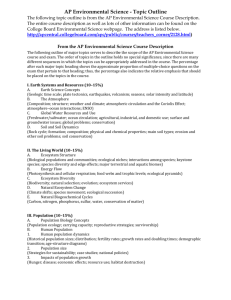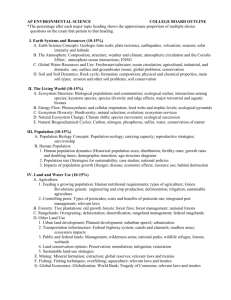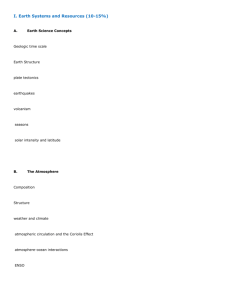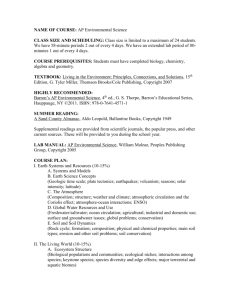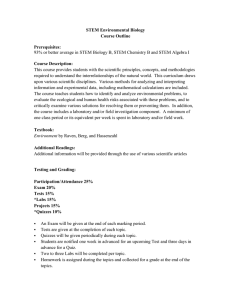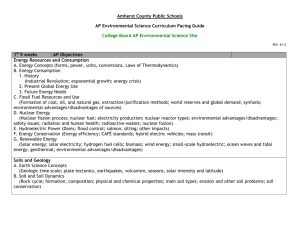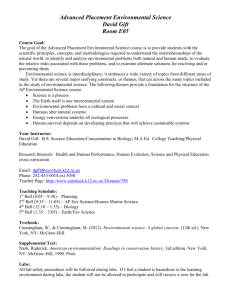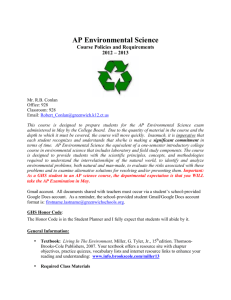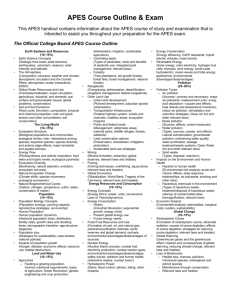File - Earth & Environmental Science
advertisement
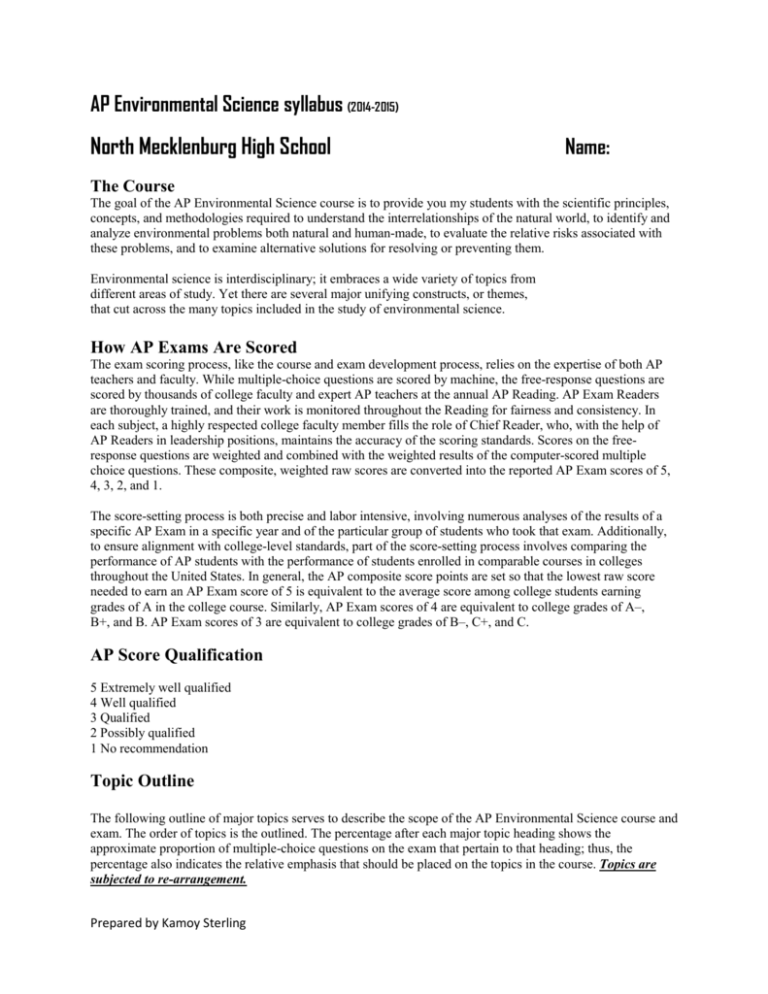
AP Environmental Science syllabus (2014-2015) North Mecklenburg High School Name: The Course The goal of the AP Environmental Science course is to provide you my students with the scientific principles, concepts, and methodologies required to understand the interrelationships of the natural world, to identify and analyze environmental problems both natural and human-made, to evaluate the relative risks associated with these problems, and to examine alternative solutions for resolving or preventing them. Environmental science is interdisciplinary; it embraces a wide variety of topics from different areas of study. Yet there are several major unifying constructs, or themes, that cut across the many topics included in the study of environmental science. How AP Exams Are Scored The exam scoring process, like the course and exam development process, relies on the expertise of both AP teachers and faculty. While multiple-choice questions are scored by machine, the free-response questions are scored by thousands of college faculty and expert AP teachers at the annual AP Reading. AP Exam Readers are thoroughly trained, and their work is monitored throughout the Reading for fairness and consistency. In each subject, a highly respected college faculty member fills the role of Chief Reader, who, with the help of AP Readers in leadership positions, maintains the accuracy of the scoring standards. Scores on the freeresponse questions are weighted and combined with the weighted results of the computer-scored multiple choice questions. These composite, weighted raw scores are converted into the reported AP Exam scores of 5, 4, 3, 2, and 1. The score-setting process is both precise and labor intensive, involving numerous analyses of the results of a specific AP Exam in a specific year and of the particular group of students who took that exam. Additionally, to ensure alignment with college-level standards, part of the score-setting process involves comparing the performance of AP students with the performance of students enrolled in comparable courses in colleges throughout the United States. In general, the AP composite score points are set so that the lowest raw score needed to earn an AP Exam score of 5 is equivalent to the average score among college students earning grades of A in the college course. Similarly, AP Exam scores of 4 are equivalent to college grades of A–, B+, and B. AP Exam scores of 3 are equivalent to college grades of B–, C+, and C. AP Score Qualification 5 Extremely well qualified 4 Well qualified 3 Qualified 2 Possibly qualified 1 No recommendation Topic Outline The following outline of major topics serves to describe the scope of the AP Environmental Science course and exam. The order of topics is the outlined. The percentage after each major topic heading shows the approximate proportion of multiple-choice questions on the exam that pertain to that heading; thus, the percentage also indicates the relative emphasis that should be placed on the topics in the course. Topics are subjected to re-arrangement. Prepared by Kamoy Sterling I. The Living World (10–15%) A. Ecosystem Structure (Biological populations and communities; ecological niches; interactions among species; keystone species; species diversity and edge effects; major terrestrial and aquatic biomes) B. Energy Flow (Photosynthesis and cellular respiration; food webs and trophic levels; ecological pyramids) C. Ecosystem Diversity (Biodiversity; natural selection; evolution; ecosystem services) D. Natural Ecosystem Change (Climate shifts; species movement; ecological succession) E. Natural Biogeochemical Cycles (Carbon, nitrogen, phosphorus, sulfur, water, conservation of matter) II. Energy Resources and Consumption (10–15%) A. Energy Concepts (Energy forms; power; units; conversions; Laws of Thermodynamics) B. Energy Consumption 1. History (Industrial Revolution; exponential growth; energy crisis) 2. Present global energy use 3. Future energy needs C. Fossil Fuel Resources and Use (Formation of coal, oil, and natural gas; extraction/purification methods; world reserves and global demand; synfuels; environmental advantages/ disadvantages of sources) D. Nuclear Energy (Nuclear fission process; nuclear fuel; electricity production; nuclear reactor types; environmental advantages/disadvantages; safety issues; radiation and human health; radioactive wastes; nuclear fusion) E. Hydroelectric Power (Dams; flood control; salmon; silting; other impacts) F. Energy Conservation (Energy efficiency; CAFE standards; hybrid electric vehicles; mass transit) G. Renewable Energy (Solar energy; solar electricity; hydrogen fuel cells; biomass; wind energy; small-scale hydroelectric; ocean waves and tidal energy; geothermal; environmental advantages/disadvantages) \ Prepared by Kamoy Sterling III. Land and Water Use (10–15%) A. Agriculture 1. Feeding a growing population (Human nutritional requirements; types of agriculture; Green Revolution; genetic engineering and crop production; deforestation; irrigation; sustainable agriculture) 2. Controlling pests (Types of pesticides; costs and benefits of pesticide use; integrated pest management; relevant laws) B. Forestry (Tree plantations; old growth forests; forest fires; forest management; national forests) C. Rangelands (Overgrazing; deforestation; desertification; rangeland management; federal rangelands) D. Other Land Use 1. Urban land development (Planned development; suburban sprawl; urbanization) 2. Transportation infrastructure (Federal highway system; canals and channels; roadless areas; ecosystem impacts) 3. Public and federal lands (Management; wilderness areas; national parks; wildlife refuges; forests; wetlands) 4. Land conservation options (Preservation; remediation; mitigation; restoration) 5. Sustainable land-use strategies E. Mining (Mineral formation; extraction; global reserves; relevant laws and treaties) F. Fishing (Fishing techniques; overfishing; aquaculture; relevant laws and treaties) G. Global Economics (Globalization; World Bank; Tragedy of the Commons; relevant laws and treaties) IV. Pollution (25–30%) A. Pollution Types 1. Air pollution (Sources — primary and secondary; major air pollutants; measurement units; smog; acid deposition — causes and effects; heat islands and temperature inversions; indoor air pollution; remediation and reduction strategies; Clean Air Act and other relevant laws) 2. Noise pollution (Sources; effects; control measures) 3. Water pollution Prepared by Kamoy Sterling (Types; sources, causes, and effects; cultural eutrophication; groundwater pollution; maintaining water quality; water purification; sewage treatment/septic systems; Clean Water Act and other relevant laws) 4. Solid waste (Types; disposal; reduction) B. Impacts on the Environment and Human Health 1. Hazards to human health (Environmental risk analysis; acute and chronic effects; dose-response relationships; air pollutants; smoking and other risks) 2. Hazardous chemicals in the environment (Types of hazardous waste; treatment/disposal of hazardous waste; cleanup of contaminated sites; biomagnifications; relevant laws) C. Economic Impacts (Cost-benefit analysis; externalities; marginal costs; sustainability) V. Global Change (10–15%) A. Stratospheric Ozone (Formation of stratospheric ozone; ultraviolet radiation; causes of ozone depletion; effects of ozone depletion; strategies for reducing ozone depletion; relevant laws and treaties) B. Global Warming (Greenhouse gases and the greenhouse effect; impacts and consequences of global warming; reducing climate change; relevant laws and treaties) C. Loss of Biodiversity 1. Habitat loss; overuse; pollution; introduced species; endangered and extinct species 2. Maintenance through conservation 3. Relevant laws and treaties VI. Earth Systems and Resources (1 0–15%) A. Earth Science Concepts (Geologic time scale; plate tectonics, earthquakes, volcanism; seasons; solar intensity and latitude) B. The Atmosphere (Composition; structure; weather and climate; atmospheric circulation and the Coriolis Effect; atmosphere– ocean interactions; ENSO) C. Global Water Resources and Use (Freshwater/saltwater; ocean circulation; agricultural, industrial, and domestic use; surface and groundwater issues; global problems; conservation) D. Soil and Soil Dynamics (Rock cycle; formation; composition; physical and chemical properties; main soil types; erosion and other soil problems; soil conservation) Prepared by Kamoy Sterling VII. Population (10–15%) A. Population Biology Concepts (Population ecology; carrying capacity; reproductive strategies; survivorship) B. Human Population 1. Human population dynamics (Historical population sizes; distribution; fertility rates; growth rates and doubling times; demographic transition; age-structure diagrams) 2. Population size (Strategies for sustainability; case studies; national policies) 3. Impacts of population growth (Hunger; disease; economic effects; resource use; habitat destruction) Laboratory and Field Investigation The AP Environmental Science course must include a strong laboratory and field investigation component. Lab activities and test that are missed CANNOT be re-done. An alternative assignment will be given in place of the missed lab activity. Big Goals The my goal for all my AP Environmental Science students is that ateast 98% will score above average and the remaining will score average given the fact that objectives are met and ALL engage meaningfully in ALL activities. Materials Needed (everyday) 2 Hard cover notebooks pencils clean erasers Blue or black ink pen (ONLY) 1 ruler Classroom Expectations 1. 2. 3. 4. 5. 6. 7. 8. Be on time for class with ALL materials and ready to learn. Respect ideas and opinions of others. Raise your hands if you have a question or comment. Permission MUST be granted in order for one to leave their seat. Eating and drinking are NOT permitted in the classroom. Electronic devices are NOT allowed without teacher’s permission. ALL assignments are to be turned in on time. Follow ALL other policies of North Mecklenburg High School. CMS Grading policy A 93%-100% B 85%-92% C 77%-84% D 70%-76% Prepared by Kamoy Sterling E 70% AND BELOW Grading weights 70% formal: test and quizzes 30% informal: homework and class work Please make the best use of my office hours With your co-operation we will exceed the Standards!!!! Student signature:……………………………………….date: …………………………………………….. Parents signature:……………………………………….. date:………………………………………………… Prepared by Kamoy Sterling
